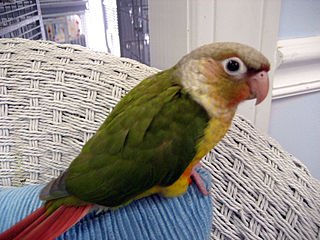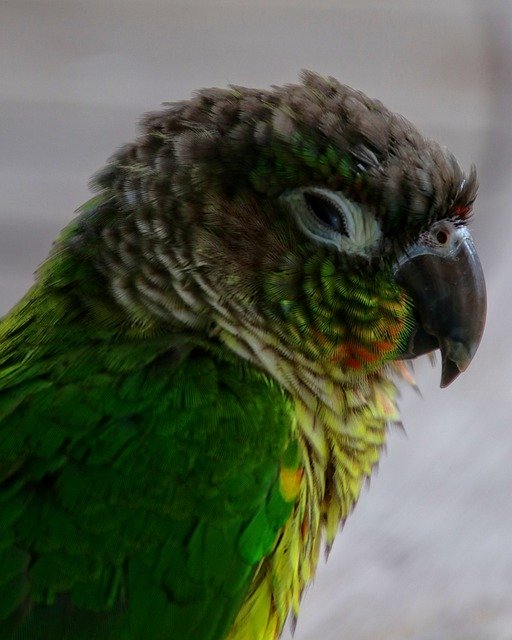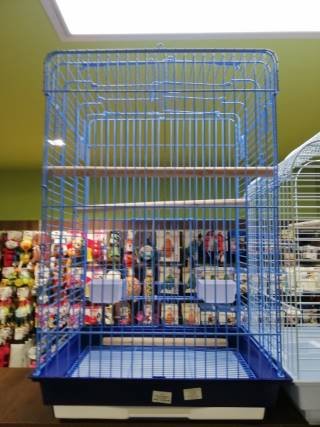One of the most loved members of the conure family, Green Cheek Conure, is a favorite among novice bird lovers and apartment dwellers. Covered in a mix of predominantly green and gray scallopings, the Green Cheek Conures are slightly smaller and a lot quieter than their cousin Sun conures from another genus Aratinga. This is the primary reason many conure lovers adopt them over the vividly-colored sun or jenday conures.
And for those who are here right before adopting this playful parrot, here is a complete guide of their care, starting from their very-first stage of being an egg to being an adult. Let’s get started without much ado.
Green Cheek Conure Egg

Just like humans, the health of a parrot is greatly determined by the diet and quality of his mother’s health. If the mother hen is fed well and taken good care of, the baby will not only hatch from the egg successfully but will also grow into a healthy adult. Hence, the best breeding care means an enhanced success at hatching and a better chance at longevity and great health. Simply follow some of the tips for the breeding hen:
- A nest box or log is always added to the usual cage of a green cheek conure to allow the pair to breed successfully. It is important to keep this nest box as clean as possible with regular cleaning as a sick mother would pass on the disease to her yet-to-come chicks.
- The body temperature of an expectant hen is almost always fluctuating with all the hormonal changes going on inside her body. It is advised by the experts to add as much warmth to her living area as possible. To do so, line his cage and nest box with organic wood shavings.
That said, green cheeks are famed for removing all the floor linings before laying their eggs and prefer to do so on the bare floor. But until that day, it is wise to keep the floor lined for insulation. Alternatively, in chillier times, add a heating pad to the cage floor or a bird lamp to offer the much-needed comfort to the mother hen. - Just like cage necessities, the dietary needs for a breeding green cheek hen is different than that of his other life stages. Apart from having an optimum quantity of all the nutrients in her body profile, having an added supply of calcium is a must for a breeding green cheek conure female. This is imperative to let her synthesize the shells of the eggs without losing her bone density. If the shells of the eggs aren’t formed, it is a lost breeding attempt.
It has been noted in varied cases that calcium deficiency often proves to be fatal for the breeding hen and her eggs. A common health disease known as egg binding leads to complications while laying eggs and the hen is at a greater risk of losing her life. To address this issue, add extra calcium to the hen’s diet. Keeping a cuttlebone or a mineral block is the most famous way of doing so. - One of the most ignored factors during the breeding of a green cheek conure pair is their changed breeding behavior. Most of the owners ignore this change by leaving the bird on his own. The pair often becomes aggressive towards each other and territorial to cage mates, if any. It is important to act in such a tense situation before it goes out of hand and the birds end up hurting each other badly.
If the pair picks up a fight with each other or with other cage mates, the foremost thing to do is to separate the birds immediately and house them individually in different cages until their aggression subsides. Before putting them back in the same cage, it is advised to first place their cages nearby to judge their behavior towards each other. Once they are seemingly calmer towards each other, house them back together. - Lastly, nest inspection is not taken positively by the pair for an obvious invasion of privacy. But if necessary, always wait for the pair to leave the nest to avoid facing their extreme aggression.
Green Cheek Conure Breeding Facts
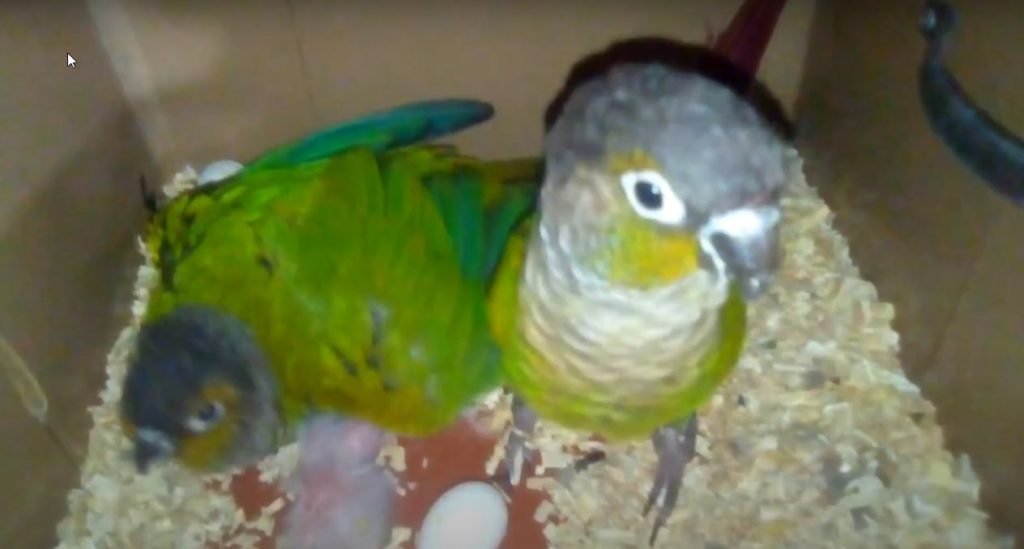
- The green cheeks attain sexual maturity at the age of one year. Though most of them can breed even before turning one, it is not advised to do so as it can negatively impact their health.
- The average green cheek conure clutch size ranges between 4 to 6 eggs. The incubation takes around 22 to 25 days, mostly averaging at around 24 days.
- The hen and the cock both take turns to hatch the eggs and also share all the other nest responsibilities.
Green Cheek Conure Baby
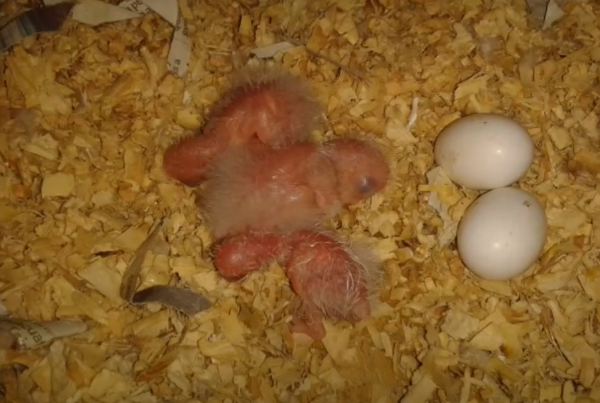
After hatching from the egg, a green cheek conure baby needs immediate special attention for the best survival. The care sheet of a green cheek baby is completely different than that of an adult green cheek.
Try to ensure all of the following for the best health of a green cheek conure baby:
- The moment the chicks hatch from the eggs, ensure a stable temperature for the chicks. The temperature in the room must not fall below 65 degrees Fahrenheit or rise above 80 degrees. The sensitive system of the new-born takes time to get accustomed to extreme temperatures.
- The next thing to ensure is offering a good living place to the baby bird. To take optimum care of the bird, a dark and congested place like a nest box is completely unfit. That said, no baby parrot can be housed in a regular cage because of the small size of the baby chick. The chick may come out of the bar spacings any time and end up hurting himself.
- So, the most famous way of housing a green cheek baby safely is in a brooding box. It is nothing but a wooden box open from the top. The box is lined with wood shavings or such organic material for warmth. It is imperative to choose a box with all the four walls slightly higher to prevent the chick from jumping out of the box.
- Just like the cage, the diet of the green cheeks when infants are met differently than that of an adult bird. Since the chicks are unable to eat on their own, they are fed a baby formula just like a human baby. The most popular way is to fill it in the syringe and feed the bird with it.
- Make sure to choose a high-quality baby parrot food to feed the bird. Such formulas are famed to have balanced and optimum nutrients that are necessary for the little bird. Generally, the baby green cheeks are fed twice a day as it covers their dietary needs. But it is still advised to follow the instructions written on the package. If still, the confusion persists, having the advice of the vet is recommended.
- Lastly, it is always advised to keep a watch on the little bird. Since the surroundings are new for him, the curious bird might make him fall for trouble accidentally. There have been instances of little chicks getting hurt by messing up with the air conditioner dents.
Green Cheek Conure Adult
When the little green cheek baby has grown enough that it seems impossible to contain his high jumps and energy inside the brooder box, it’s time to declare him almost an adult. Though the official status is attained only after the first molt. With a changed status, the needs of a green cheek conure also change drastically. Here’s a completely different care sheet for adult green cheek conures:
Having an appropriately sized cage is the foremost need for a green cheek. It becomes all the more urgent to keep the bird safe. Being a playful and active bird, a green cheek demands a large cage. It is advised to have a cage with dimensions of around 24 inches in length, breadth, and height. This will facilitate the optimum movement of the bird and will allow him to flex his wings by taking short flights.
Additionally, cage accessories are equally important to offer a comfortable and healthy life to the green cheek. Add around 4-5 perches at varying heights. The perches must be of varying thickness and lengths. This would not only make the bird feel at home but also keep his muscles active and bones healthy.
Where perches are for the best of the physical health of the green cheek, toys are a must for their mental wellness. Foremost, they keep the bird engaged and prevent them from getting bored and fall into depression. A bonus is that these toys challenge the bird at intellectual levels too. Offer them foraging toys and see the bird becoming little Sherlock Holmes.
Another cage accessory is feeding bowls. Around three of them are enough; one for fruits and vegetables, another for seeds and pellets, and the third for freshwater. They can either be placed at the cage floor or clipped to the bars.
The next in line is taking care of the dietary needs of the bird. He can no longer be fed the baby formula. The most important die portion of a green cheek conure is pellets. They generally form around 50-70% of his diet. This is because, just like baby formula, a pellet portion has all the essential nutrients necessary for the green cheek. The rest of the diet portion is formed by offering:
Seeds like quinoa, chia, barley, millet, safflower, etc. Offering them as a mix of 2 or 3 is advised to prevent the bird from getting bored. Keep the quantity to just a tablespoon or two in a day as they are high in fat and can cause obesity in the bird. Also, soak them a few hours before serving to make them chewable for the bird. Alternatively, sprouting them flush out the excess fat content is considered a healthier way of offering seeds. Prefer homemade seed mix over store-bought formula as they are loaded with artificial additives and harmful salts.
Fruits and vegetables like berries, apples, mangoes, grapes, banana, plum, winter squash, pumpkin, sweet potato, carrots, corncob, et al. For the greens, add a few leaves of spinach, kale, beet greens, or broccoli. Make sure to remove the seeds of the fruits as the bird might choke on them by swallowing accidentally. Also, pitted fruits like avocado are considered poisonous for the bird, so are best avoided.
Another need for a green cheek that must be met is a regular uninterrupted freshwater supply. Just like all other living beings, water is a necessity for a green cheek too. It keeps the bird hydrated, regulates his body temperature, and transports all the essential nutrients throughout the body. Make sure to offer clean water of drinkable quality. And increase the quantity for hotter days by keeping an extra bowl full of freshwater.
Apart from the regular diet, it is imperative to add supplements to a green cheek’s diet by adding cuttlebone or other mineral blocks. This is important to cover up for any probable mineral loss. Simply keep it on the cage’s floor or hang them near one of the perches to make it possible for the bird to chew on it any time.
Lastly, for the optimum health of the bird, take care of the cage cleanliness along with all the accessories. Pay regular visits to the vet for grooming the bird and getting the annual medical checkups performed. This helps in the early detection of any illness.
Summing Up
A green cheek conure lives for around 10-15 years. But if given a safe and healthy environment, he can easily live for 30 years or even more. This all depends on the love and care he is extended by his owner. This means the diet is not the only parameter of a long life for a green cheek. This medium-sized bird demands the attention of his owner. Tending the bird well daily results in a better quality of life and a long one too.

